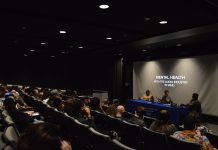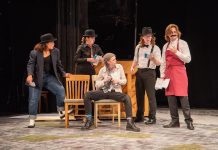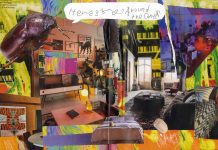
In the studio room of the Regional Arts Commission (RAC) on Delmar Boulevard, graphic designers from all over the St. Louis area gathered to view one another’s work. One of the pieces was a photo titled “Black.” It was a black and white photo of a man with his arms outstretched around a table. On the table was the word “Black” made out of artificial pearls. The photo was taken by Webster University graphic design student, Yvonne Osei.
“The assignment was to come up with one word that has meaning to you… then render it in a three-dimensional piece,” Osei said. “It was a challenge, but I picked that word ‘Black’ because it can be seen on so many levels. It lends itself to many interpretations and that’s what a strong design should do.”
Osei and Nicholas Heilig, are two Webster students who were selected to showcase their work and compete in the American Institute of Graphic Arts (AIGA) STL Design Show 17.
Every year for the past 17 years, AIGA St. Louis calls for graphic designers to submit their work. The pieces selected are then displayed in the annual design show.
Noriko Yuasa, graphic design professor, said she encouraged all her students to enter the competition this year, but only Osei and Heilig submitted their work. They entered two pieces each and all four pieces were selected. The judges this year came from different parts of the country and included:
• Martin Venezky, a designer at Appetite Engineers in California
• Eddie Opara, a partner at Pentagram in New York and
• Cheryl Towler Weese, founder and creative director at Studio Blue in Chicago.
Heilig, senior graphic design major, said having the opportunity to participate in the design show was a great benefit to him.
“AIGA is a worldwide graphic design group, so it’s something every graphic designer knows of,” Heilig said. “It’s going to be a great thing for me to put on my resume. And the fact that the three people reviewing everything that came in are really well-established designers themselves. So, to be able to say that jury selected my work is good for me.”
Osei grew up in Ghana. She said she always dreamed of flying planes, but after taking some classes in school, she began to pursue art. She moved to the United States in 2009 to attend Webster.
“As I was growing up, it wasn’t really about driving planes, but about seeing people and places. Seeing new cultures,” Osei said. “Then I realized I had a stronghold in graphic design and that could be used as a tool to communicate my feelings and whatever else I wanted to say more effectively.”
She said her work almost always focuses on addressing international concerns. The other piece Osei submitted was a poster she created to support Japan after the 2011 tsunami. Her professor, Yuasa, is from Japan. Osei said she created that piece as a personal response to the crisis.
“I used the Japan red ball and I conceptualized it into this precious egg in a black hand that represents my culture, because that hand is Ghanyan. It’s saying ‘I support Japan and Japan can trust me,’” Osei said.
Heilig submitted a typeface he designed himself to satisfy his bachelor of fine arts requirements. One of his submissions was a poster, and the other was a booklet of each letter of the alphabet in his typeface. The letters are thick, and within them is a design he created to represent a maze.
“It’s overwhelming for people to look at and want to solve, but you kind of want to — but you kind of don’t. It was kind of a play on that idea,” Heilig said. “Since it’s a font, it can be used for anything. A lot of people that see it think intestinal or brain. It’s kind of cool to see what other people think.”
Martin Brief, co-chair of the AIGA STL Design Show 17, said over 150 designers submitted their work this year. Of those, about 40 professional pieces and approximately 15-18 student pieces were selected for the show. Yuasa said she thinks Osei and Heilig were selected this year because of the quality and creativity of their work.
“I believe the work (Heilig and Osei) had was very personal and creative. It’s very different from any other graphic design that you see in everyday life,” Yuasa said. “I try to encourage students to make their work personal and different, and I think they were very successful in doing that; in creating their own personal voice in the graphic design field.”



